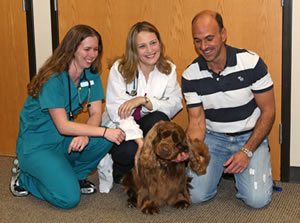Texas A&M Veterinarians Celebrate Westminster Victory of Former Patient
COLLEGE STATION, TX – With viewers around the nation watching on live television, a humble Sussex spaniel called “Stump” took the honor of “Top Dog” at the annual Westminster Kennel Club dog show. Of course, some of his biggest fans are from the Texas A&M University College of Veterinary Medicine Biomedical Sciences, and they cheer him on for a very different reason.
 Westminster Dog Show Champion Stump and handler Scott Sommers (right) pose for pictures with Dr. Katherine Snyder (center) and veterinary technician D’Lisa Ryland during Stump’s visit to the Texas A&M Veterinary Medical Center on Tuesday, February 24, 2009.
Westminster Dog Show Champion Stump and handler Scott Sommers (right) pose for pictures with Dr. Katherine Snyder (center) and veterinary technician D’Lisa Ryland during Stump’s visit to the Texas A&M Veterinary Medical Center on Tuesday, February 24, 2009.
Stump’s story begins with a very sick dog. After being seen by Dr. Matthew Dikeman at Brittmoore Animal Hospital, Stump was referred to the clinicians at Texas A&M University’s Small Animal Hospital. At the SAH, Stump was able to be seen by veterinary specialists utilizing the latest in medical treatments. Stump stayed at the SAH for 13 days, 12 of which were spent in the Intensive Care Unit.
“Stump arrived in January 2006 with a body-wide infection, infection on his heart valves, fluid in his lungs, and a blood coagulation disorder called DIC,” recalls Dr. Katherine Snyder, medical resident in charge of Stump’s case. “He was very sick. We treated him with antibiotic therapy, heart medications, oxygen, and some anticoagulant medications. He really pulled through like a champion.”
Conditions like the one that Stump presented with are uncommon, according to Snyder, but they are the result of different types of bacteria circulating in the body. It’s not breed specific and can affect all kinds of dogs. The diagnosis is a difficult one, often with no way to prove where it started or why it developed. The prognosis for dogs that experience these infections is usually guarded to poor – with an uphill battle for survival. Fortunately, given the right medications and enough time, dogs can completely recover from this serious illness.
“It’s not easy to diagnose, but there are signs that dog owners should watch for,” added Snyder.
“Fever, lethargy, poor appetite, a heart murmur, difficulty breathing, or coughing can all be signs that something is not right with the dog. Owners should take their dogs to the veterinarian as quickly as possible after noticing these symptoms so that appropriate treatment measures can be started in a timely fashion.”
Stump’s story is about survival, and while the world will recognize him as Best in Show from Westminster, the Texas A&M College of Veterinary Medicine will recognize him as the champion of their hearts.


